This baked pistachio cheesecake is creamy smooth, bejewelled with pistachio slivers and gleaming with golden honey.
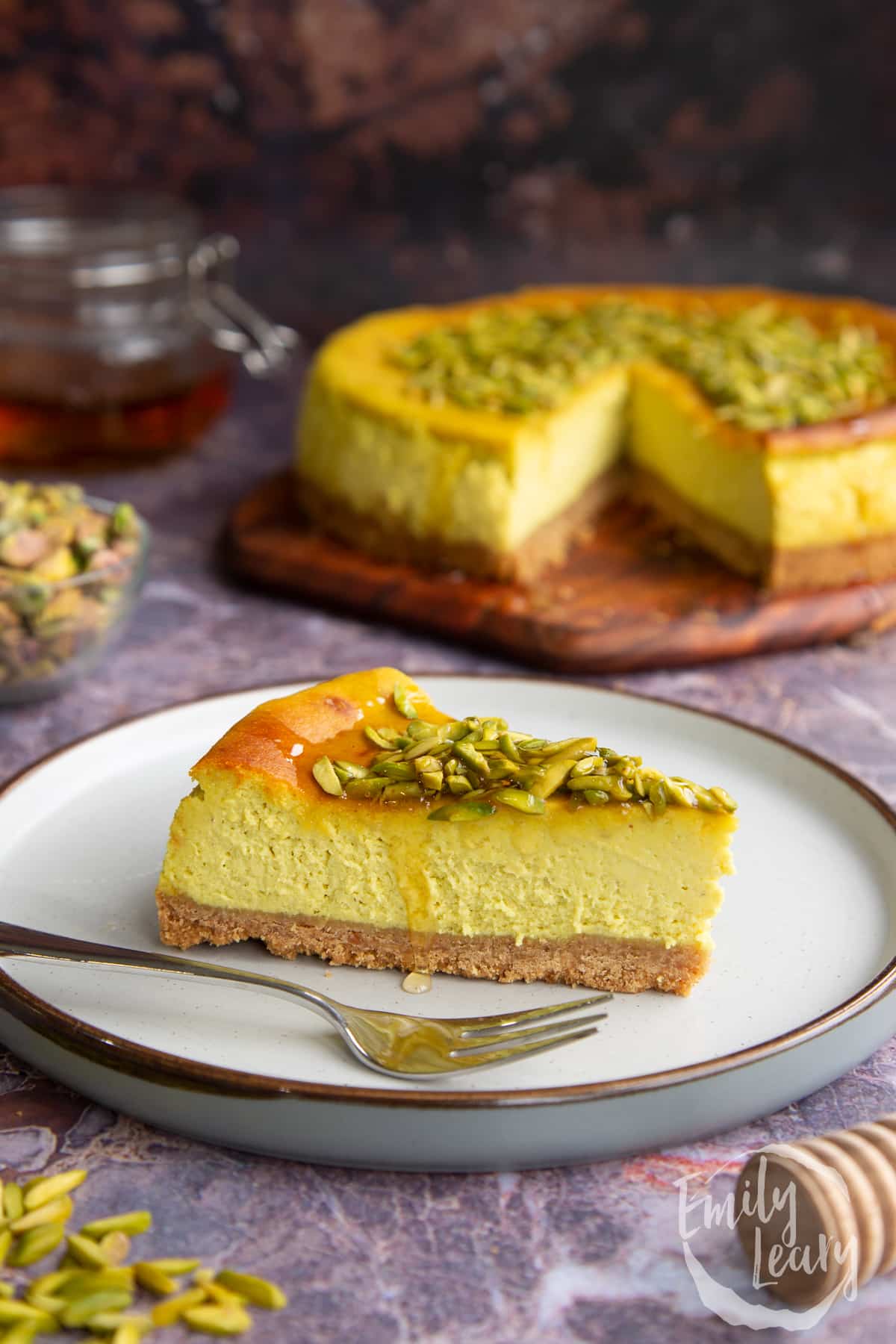
The flavour of the pistachios really comes through in the sweet-but-not-too-sweet filling and the smooth, baked texture pairs dreamily with the crunchy pistachios and light honey drizzle.
The base is made from digestive biscuits (or graham crackers), crushed and combined with melted butter and a little sugar before being pressed into the base of a cake tin and baked for 5 minutes to help it firm up.
The filling is then made with cream cheese, double cream, eggs, vanilla, flour, sugar and a large helping of pistachio paste. The ingredients are whisked together and then, optionally, tinted a slightly more vibrant green with a touch of food colouring.
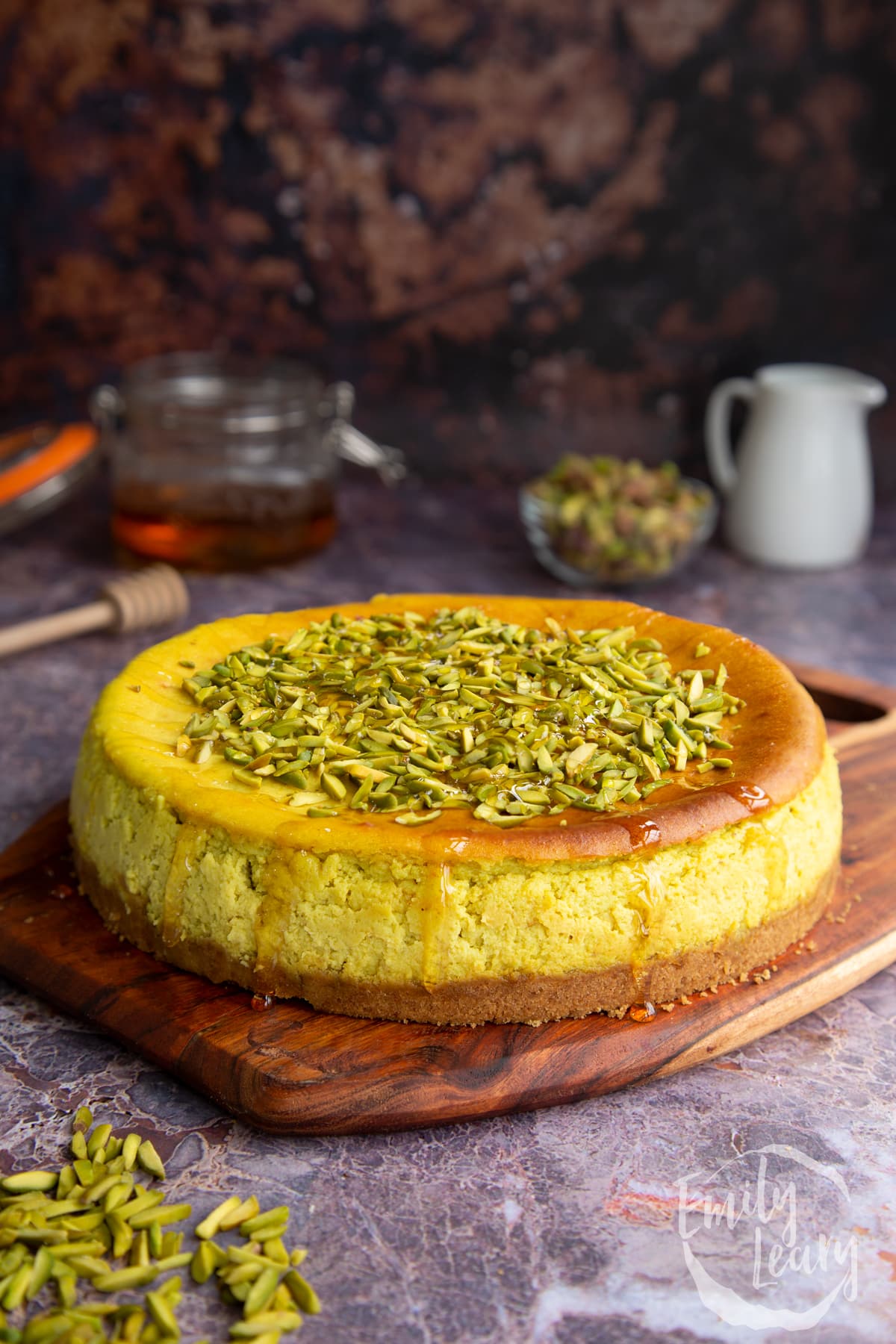
For the pistachio paste, you can use store-bought or you can make your own using my easy guide to making your own pistachio paste. It's really easy to do at home, tastes incredible and requires just one ingredient: pistachios!
You'll pour the filling on top of your biscuit base and bake the cheesecake for 1 hour before chilling overnight for the perfect texture.
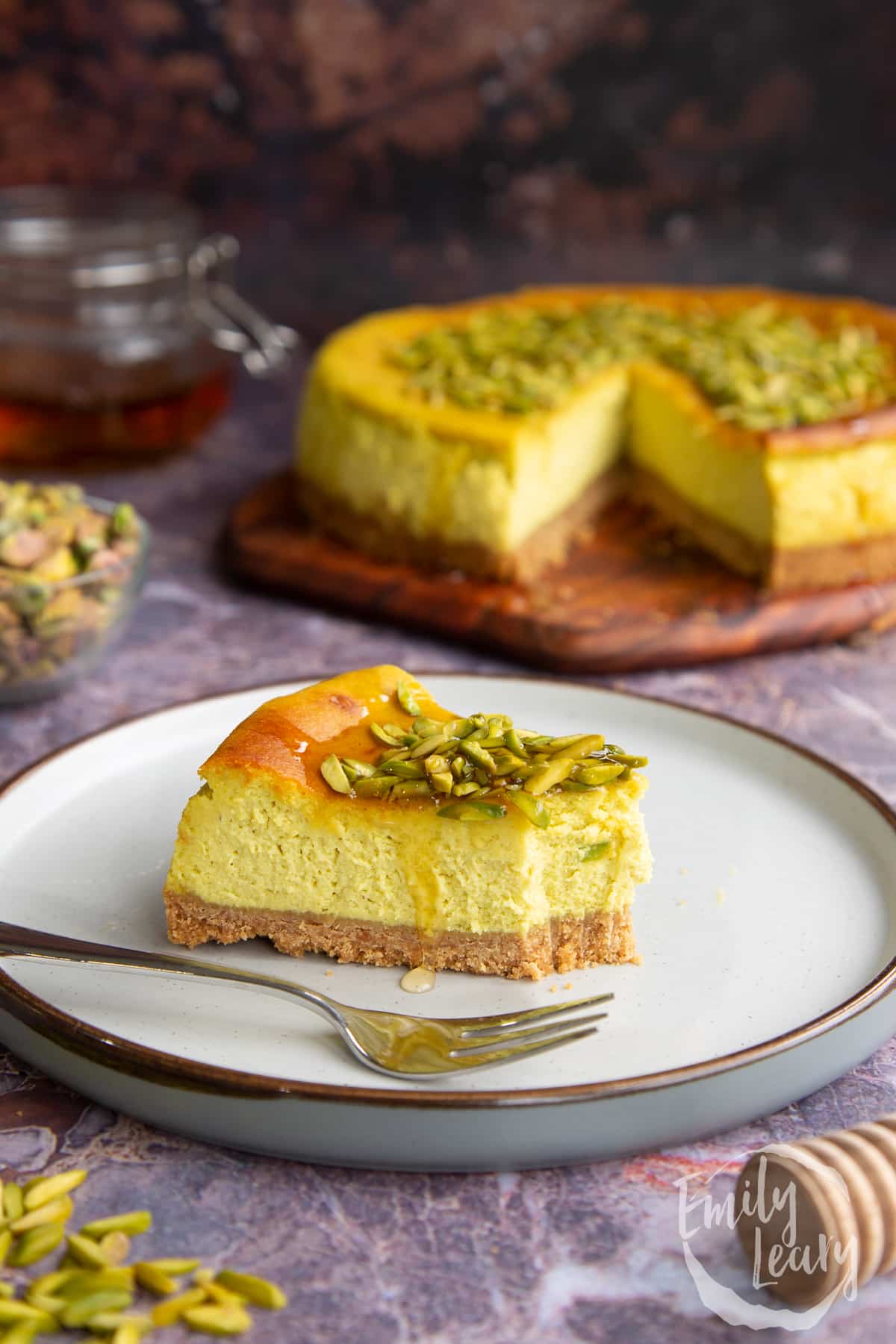
When you're ready to serve, you'll release the cheesecake from its tin and adorn with pistachios and honey. I'm so proud of this beautiful pistachio cheesecake. It not only looks positively majestic, it tastes it too!
Here's the full recipe for my pistachio cheesecake. I've included lots of step-by-step images to help you along the way.
Ingredients
For the base
- 260 g (9.2 oz) digestive biscuits (graham crackers)
- 1 tbsp golden caster sugar (superfine sugar)
- 85 g (3 oz) salted butter
For the filling
- 350 g (12.3 oz) light cream cheese room temp
- 250 g (8.8 oz) full fat cream cheese room temp
- 175 ml (5.9 floz) double cream room temp
- 2 medium free range eggs room temp
- medium free range egg yolk room temp
- 1 tbsp plain white flour (all purpose flour)
- 1 tsp vanilla extract
- 200 g (7.1 oz) golden caster sugar (superfine sugar)
- 200 g (7.1 oz) pistachio paste
To top
- 30 g (1.1 oz) pistachio slivers or chopped pistachios
- 2 tbsp honey
Instructions
Make the base
Crush or blend the biscuits to resemble coarse sand.
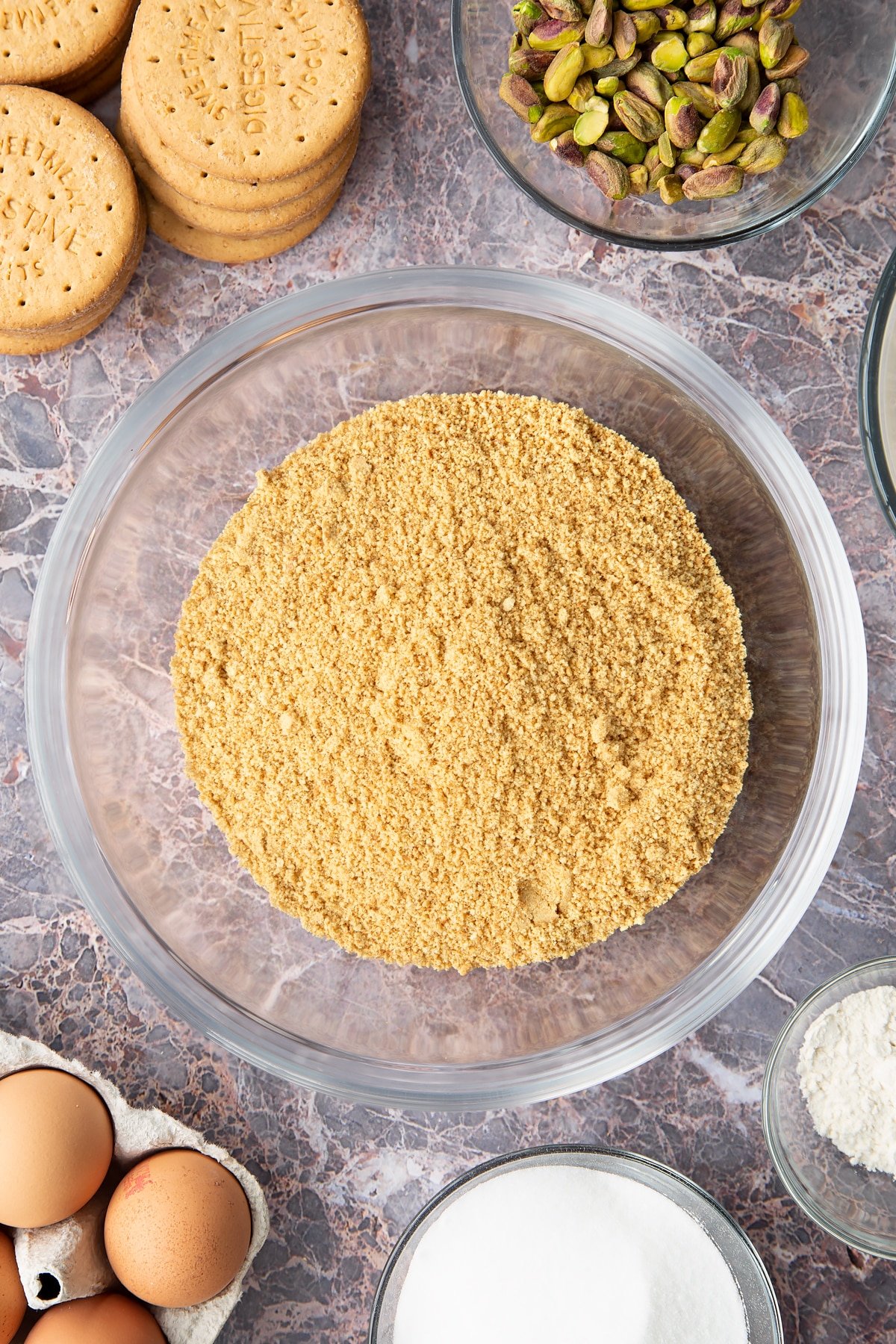
Add the sugar and melted butter.
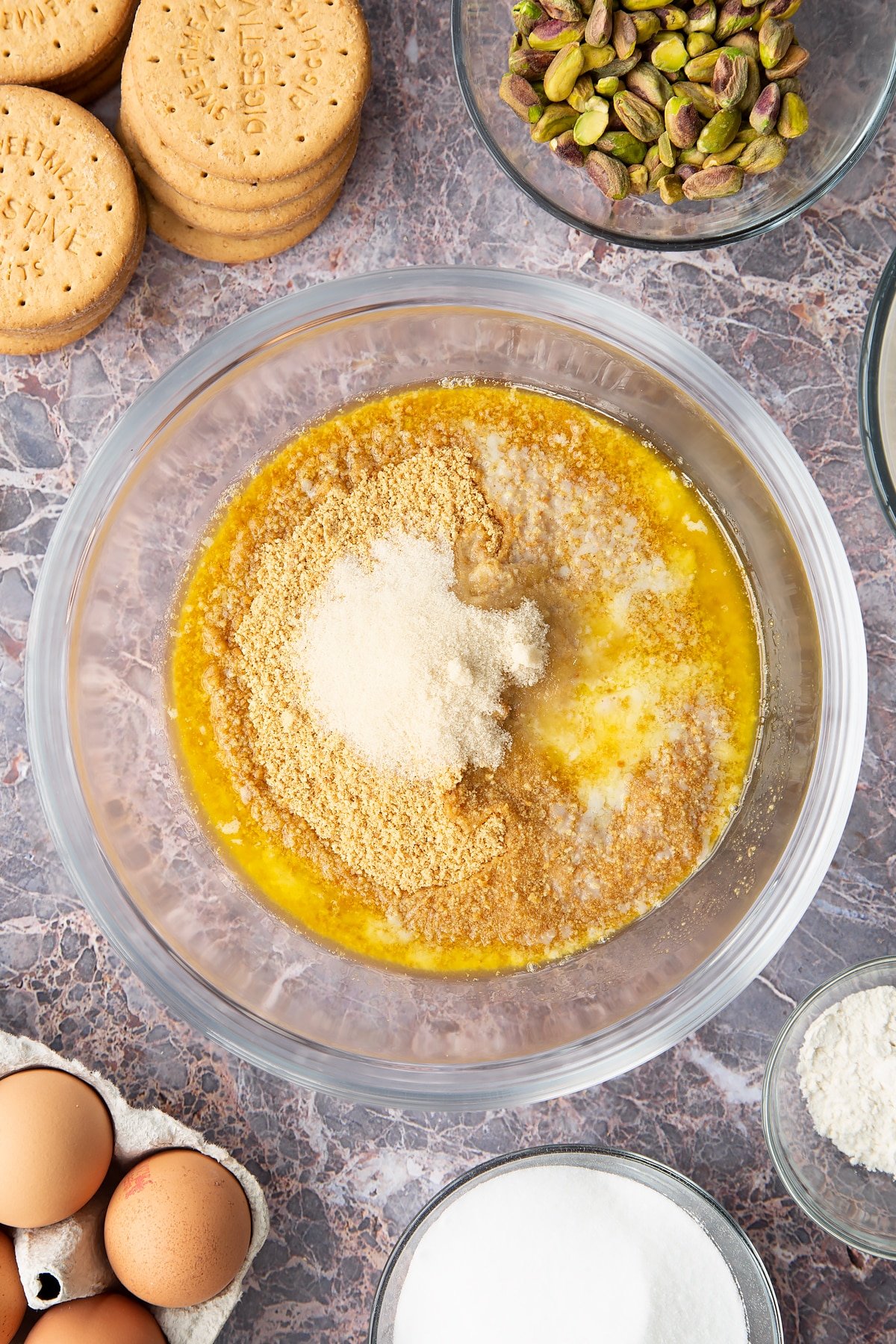
Mix well.
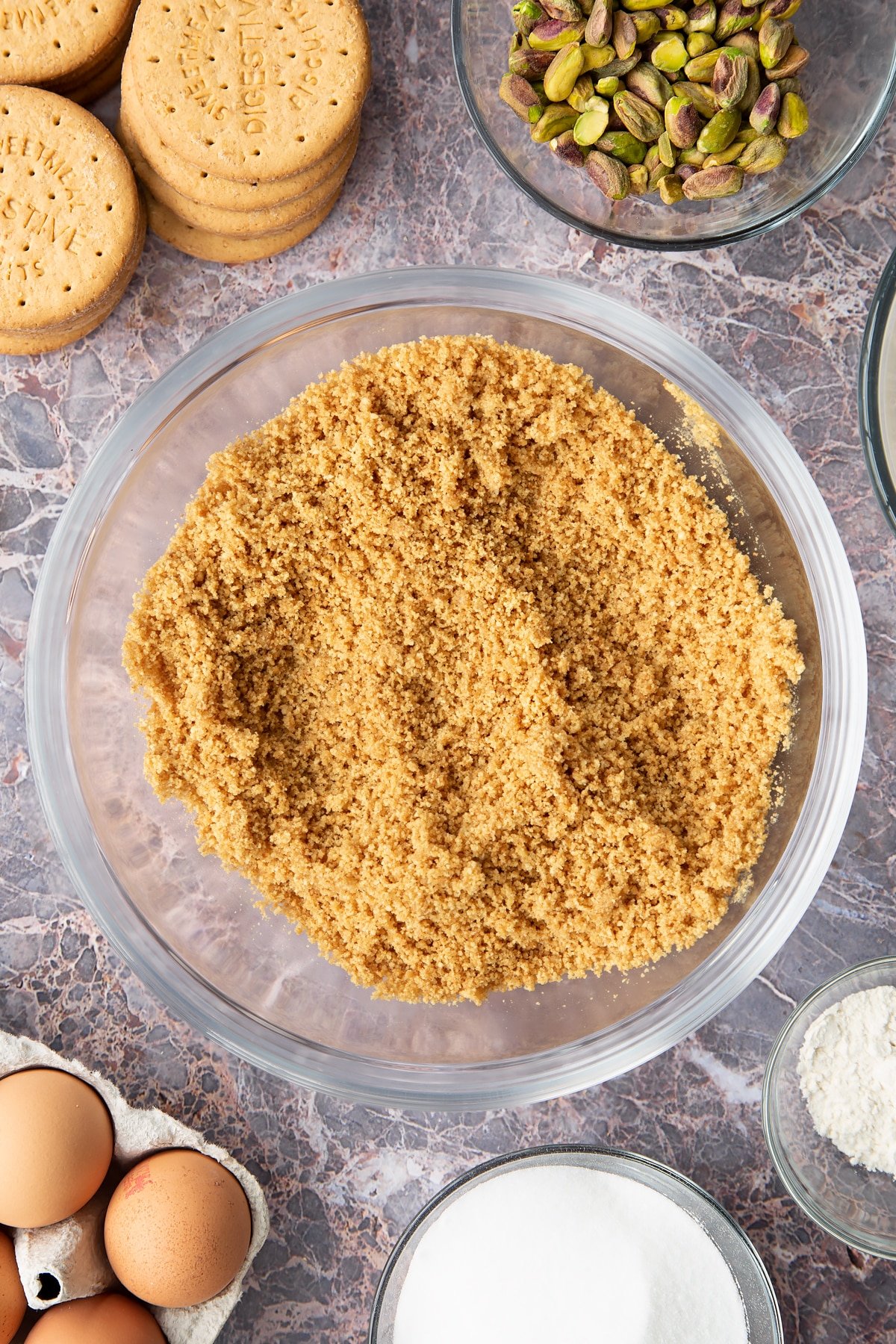
Press into the base of a large springform cake tin, flattening with a spoon or base of a tumbler.

Cook at 170C/340F (150C/300F fan) for no more than 5 mins, then set aside to cool.
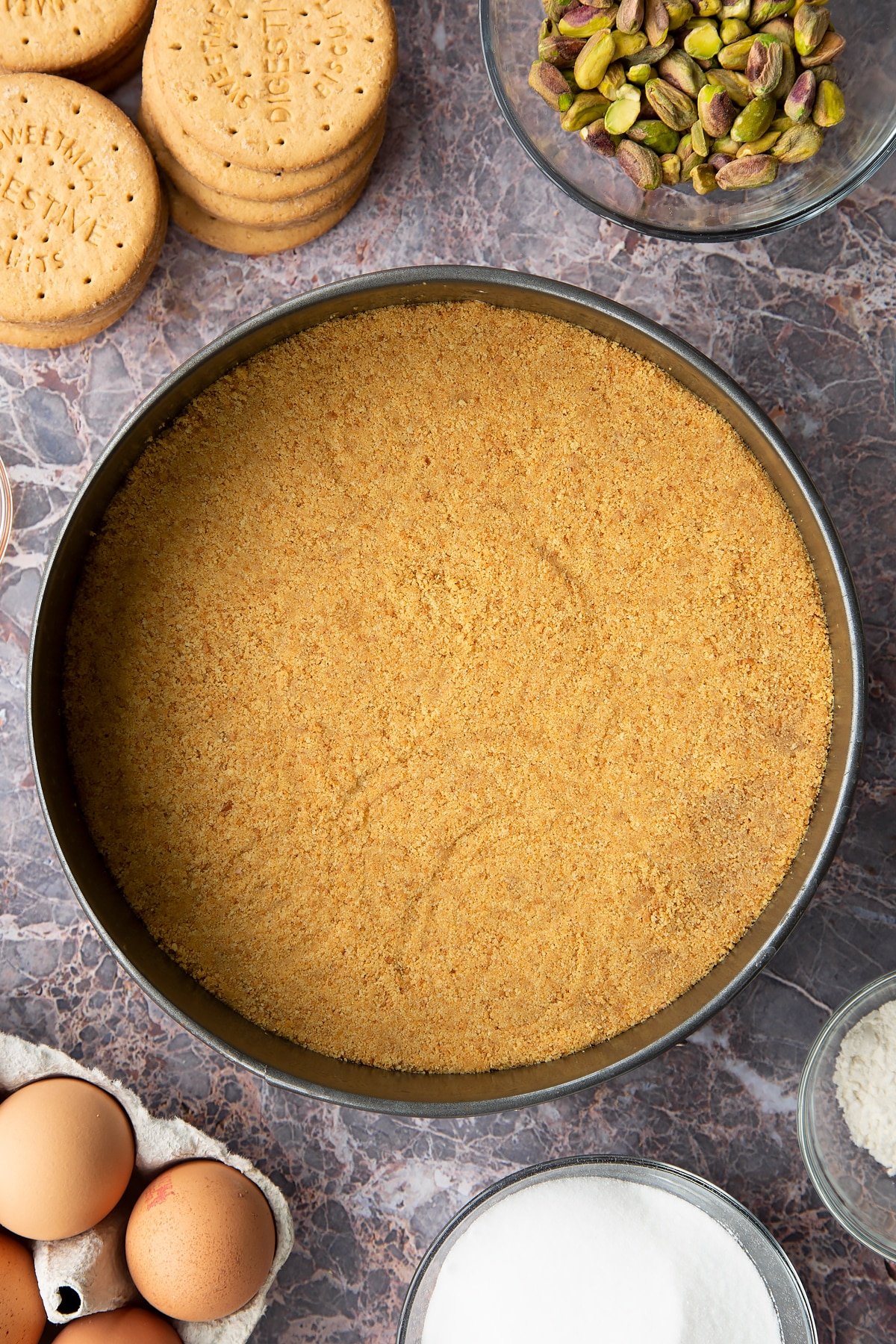
Make the filling
Put the cream cheese, double cream, eggs, flour, vanilla, sugar and pistachio paste in a large bowl.
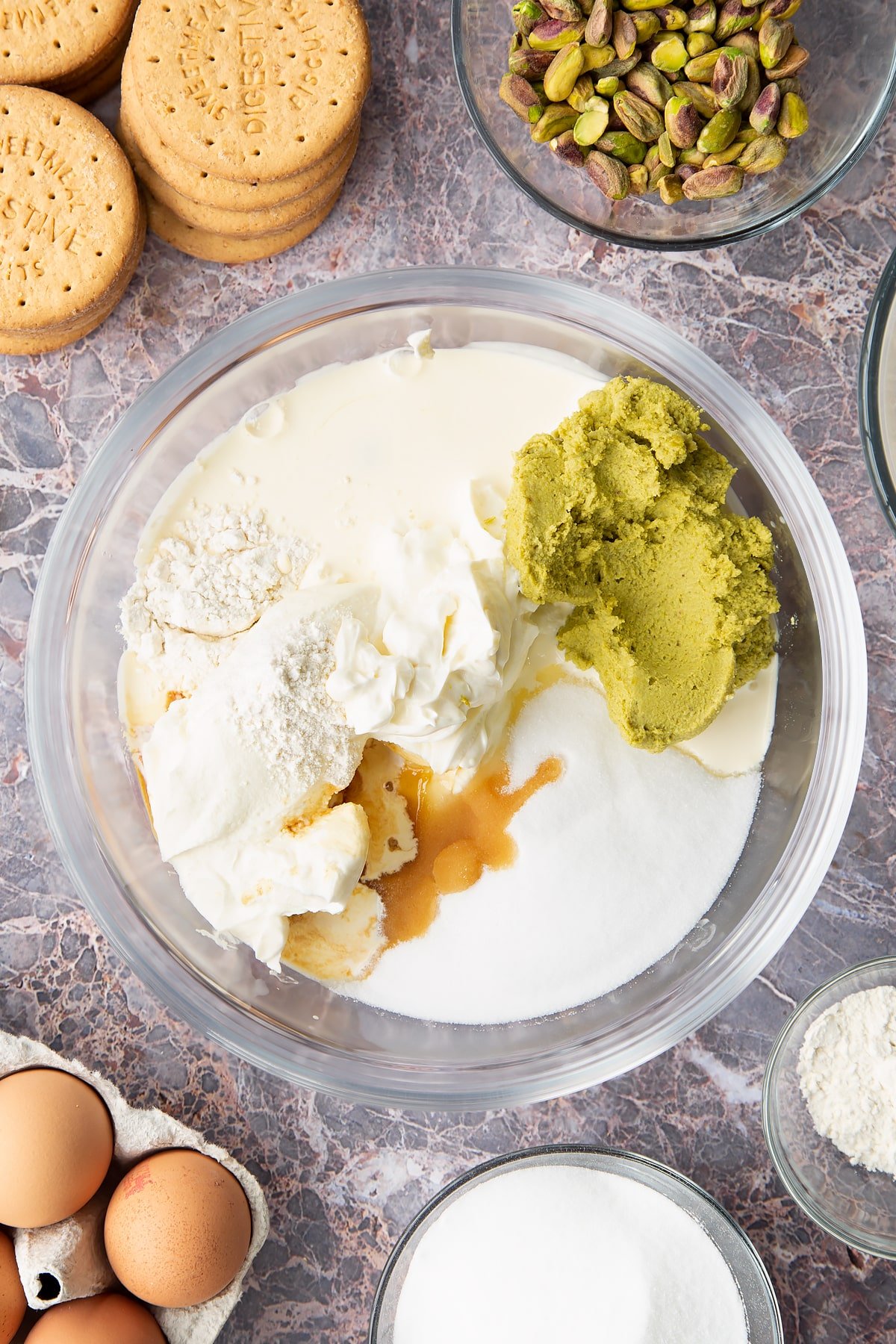
Briefly whisk together until just combined. Don't overwhisk as you'll introduce too much air.
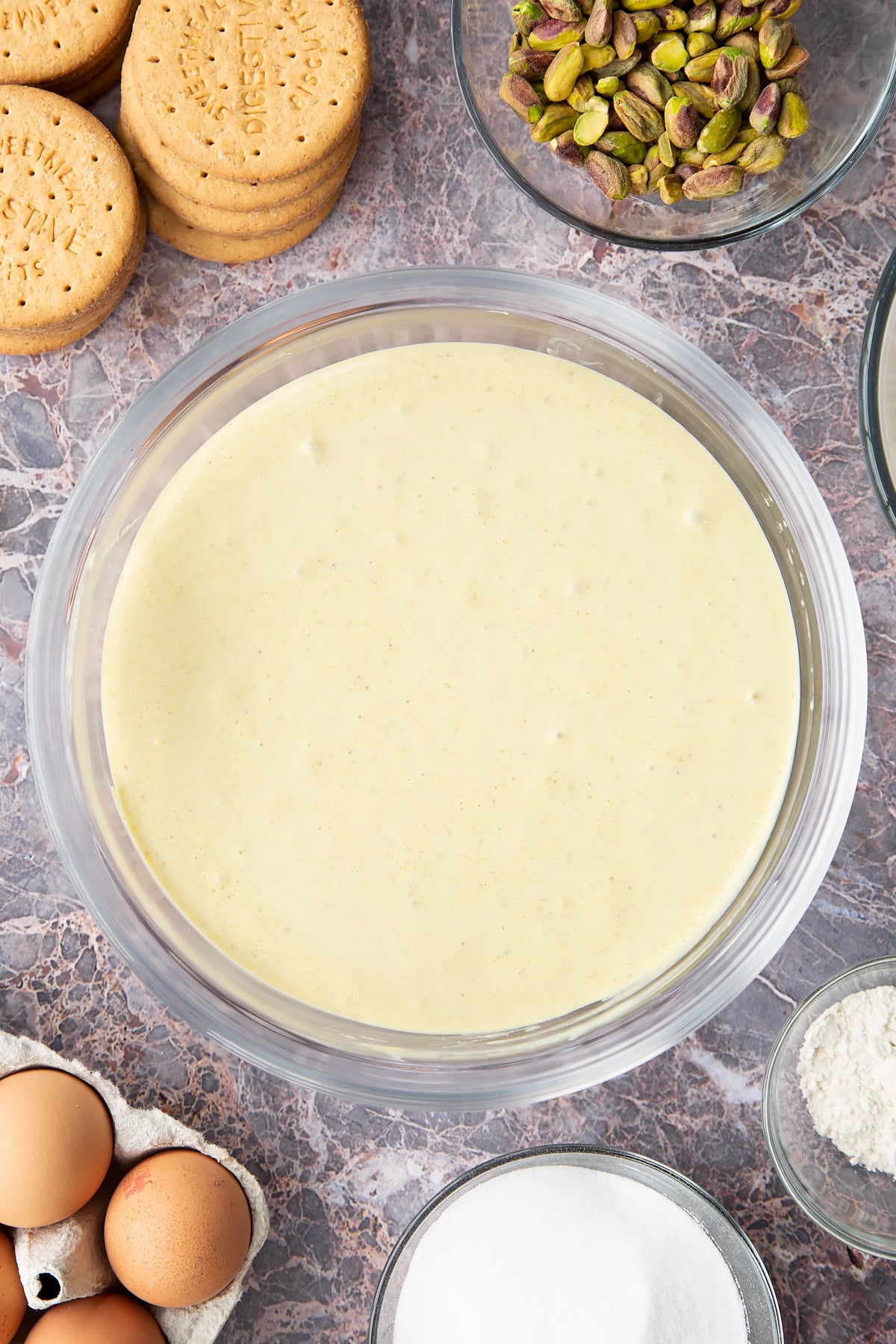
At this stage, if you like, you can add a small drop of green food colouring to make the filling more vibrant.
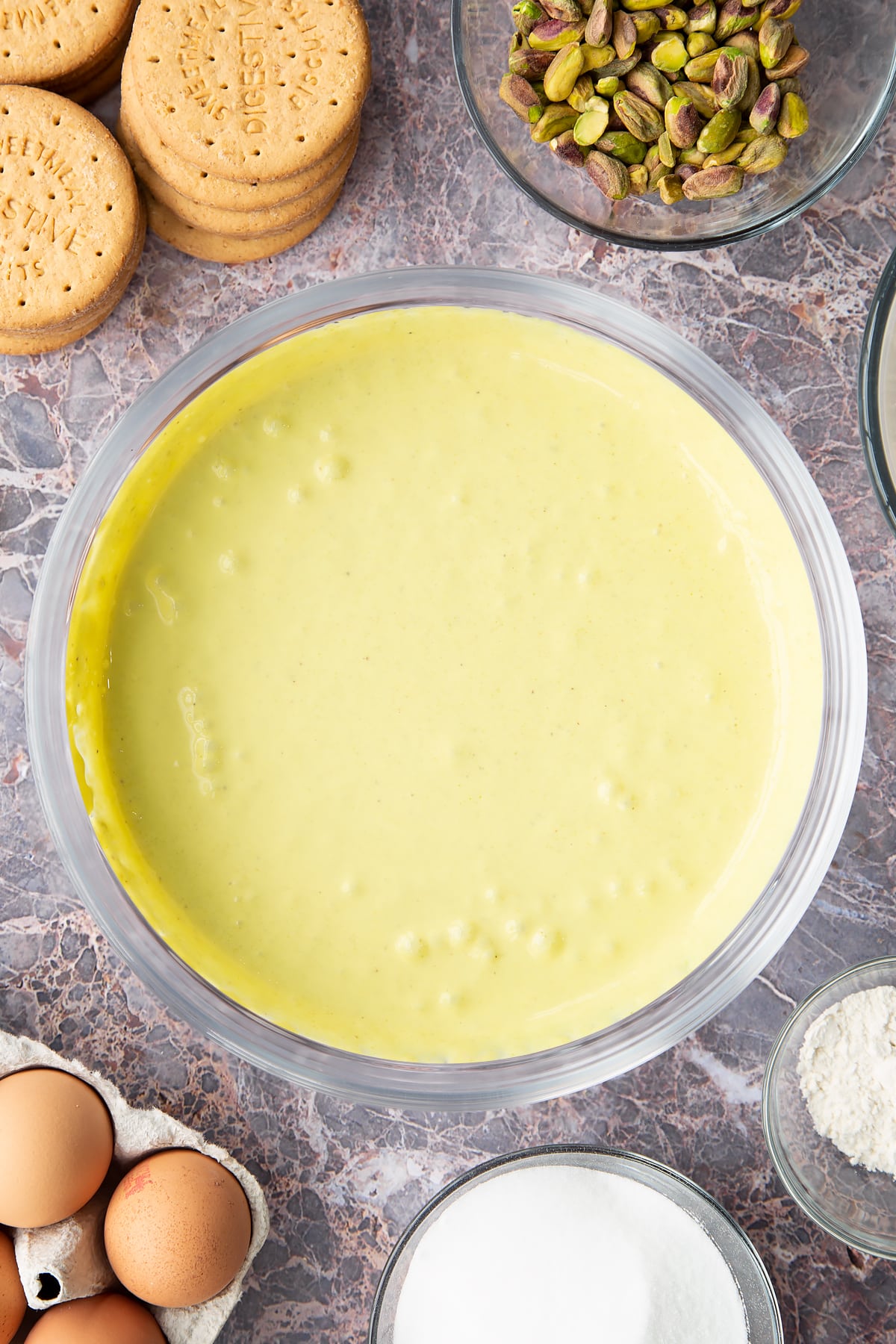
Pour the batter into the tin on top of the biscuit base.
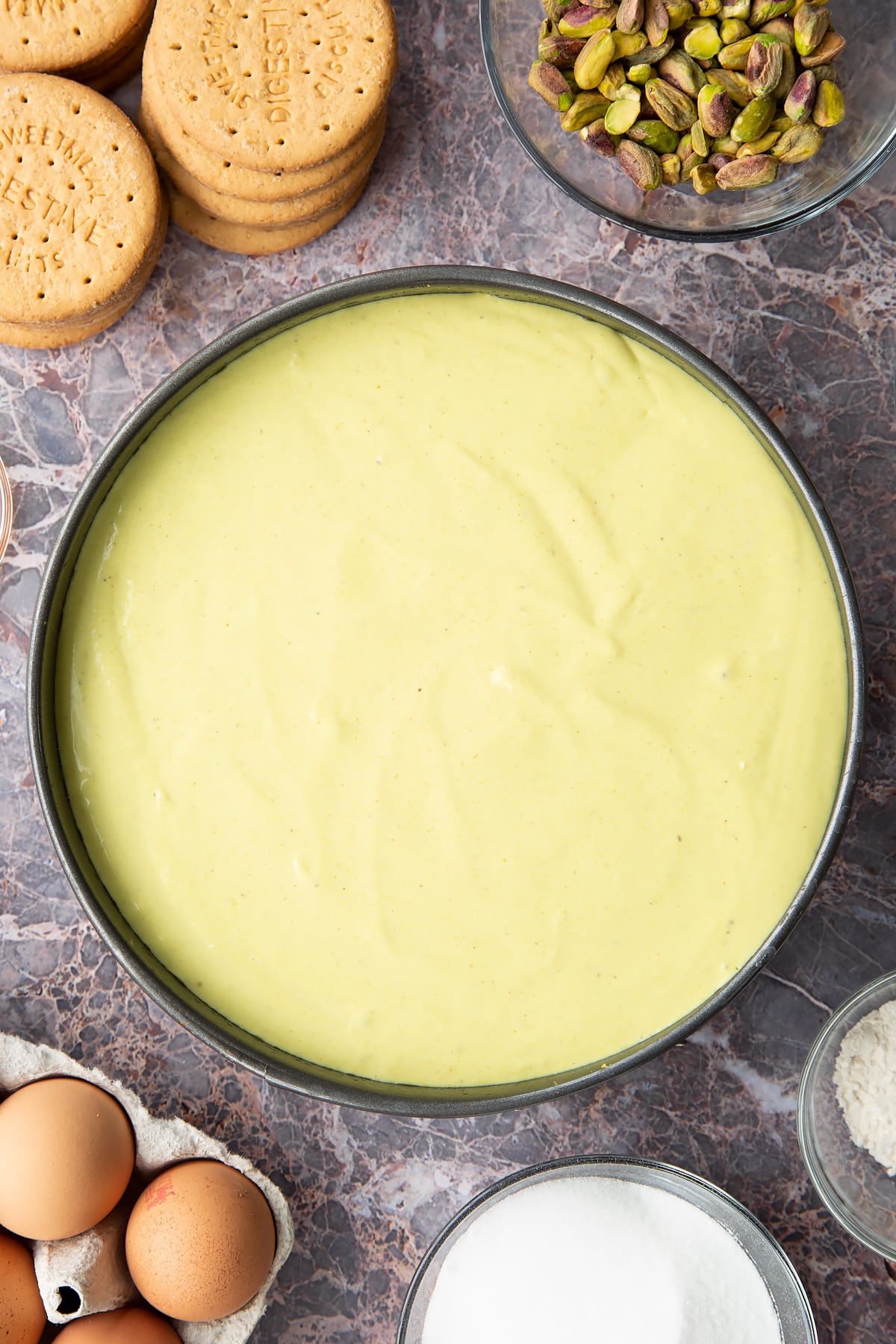
Bake at 170C/340F (150C/300F fan) for 1 hour until firm but wobbly (not ripply) if shaken.
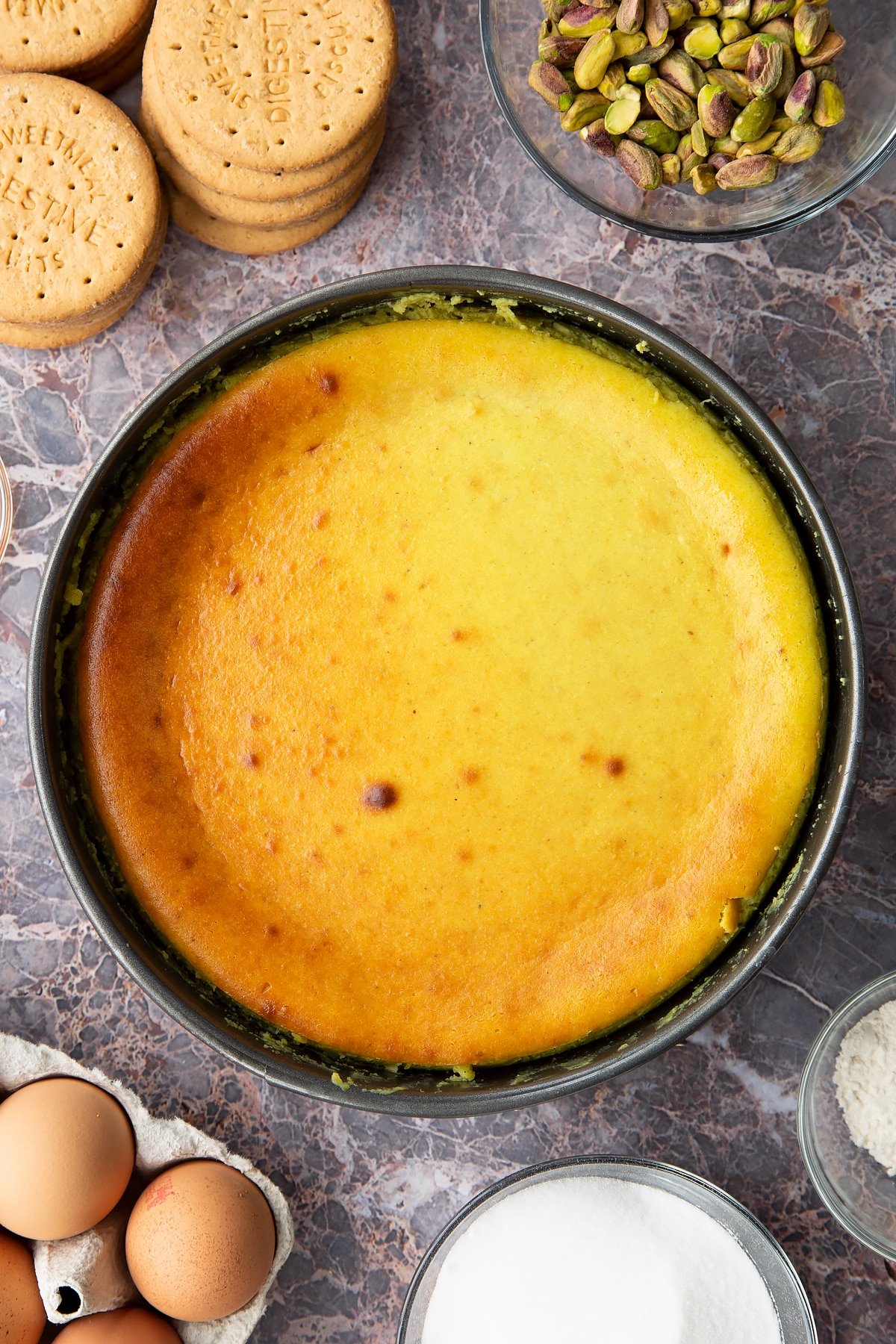
Run a sharp knife carefully around the inside of the tin to ensure the cheesecake doesn't stick, which can cause cracks as it cools.
Cool in the tin on a rack and when cold, cover and store in the fridge to set overnight.
To finish
One the cheesecake has chilled, run a knife around the inside of the tin again and unlock to release the sides. It should then lift onto a board cleanly.
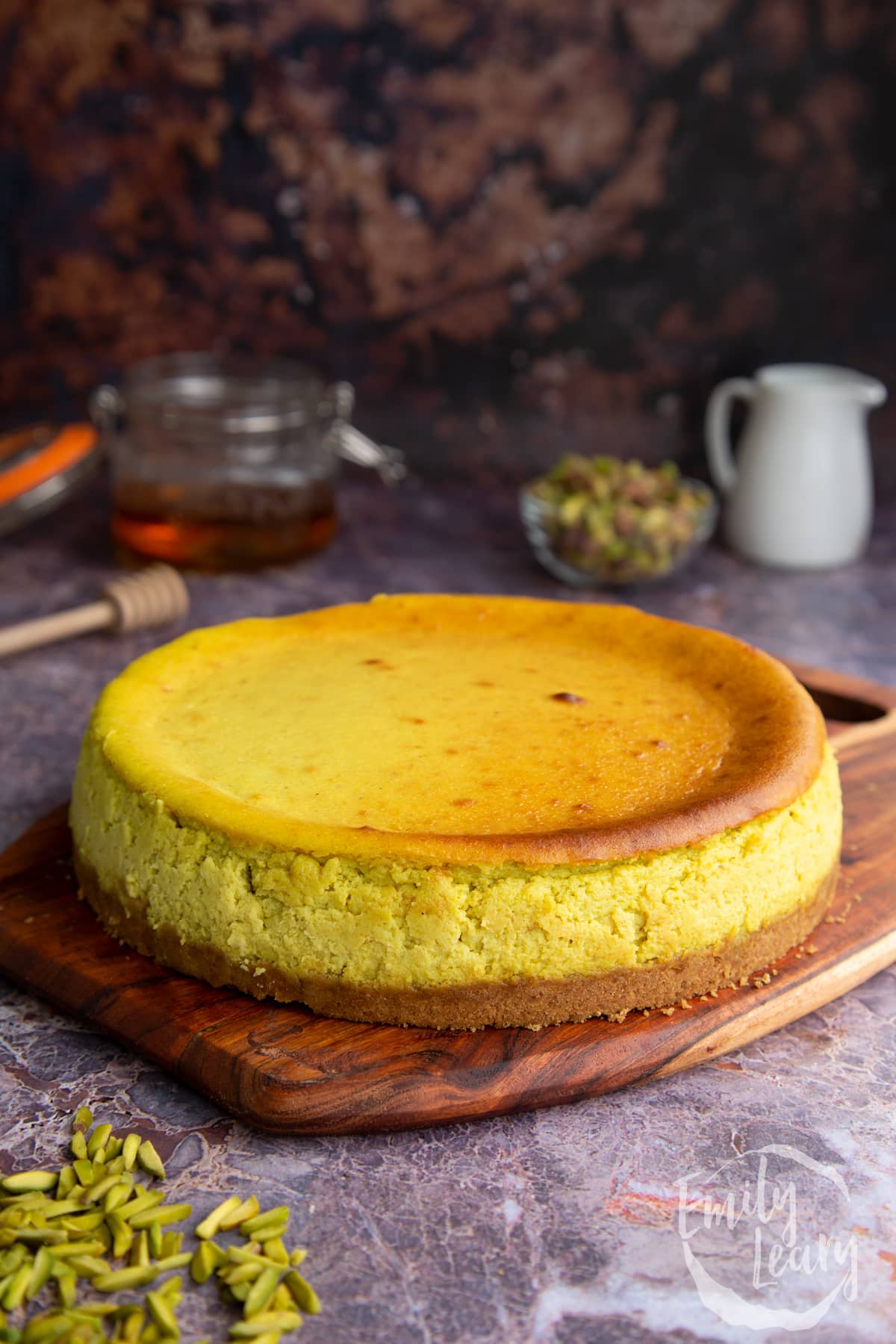
Sprinkle the pistachio slivers (or chopped pistachios) on top of the cheesecake and drizzle with honey.

Your cheesecake is now ready to slice with a sharp knife and serve.
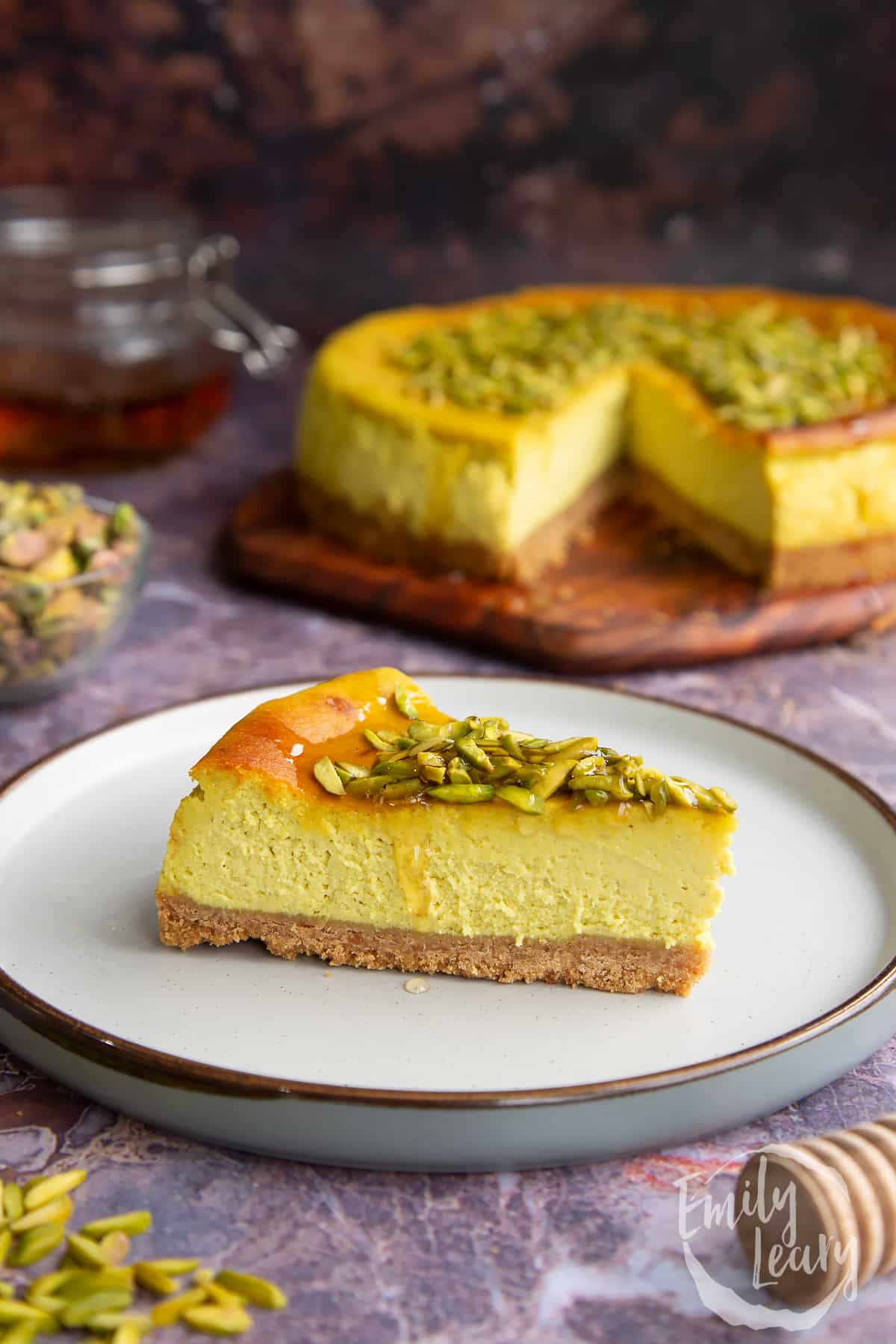
Enjoy!
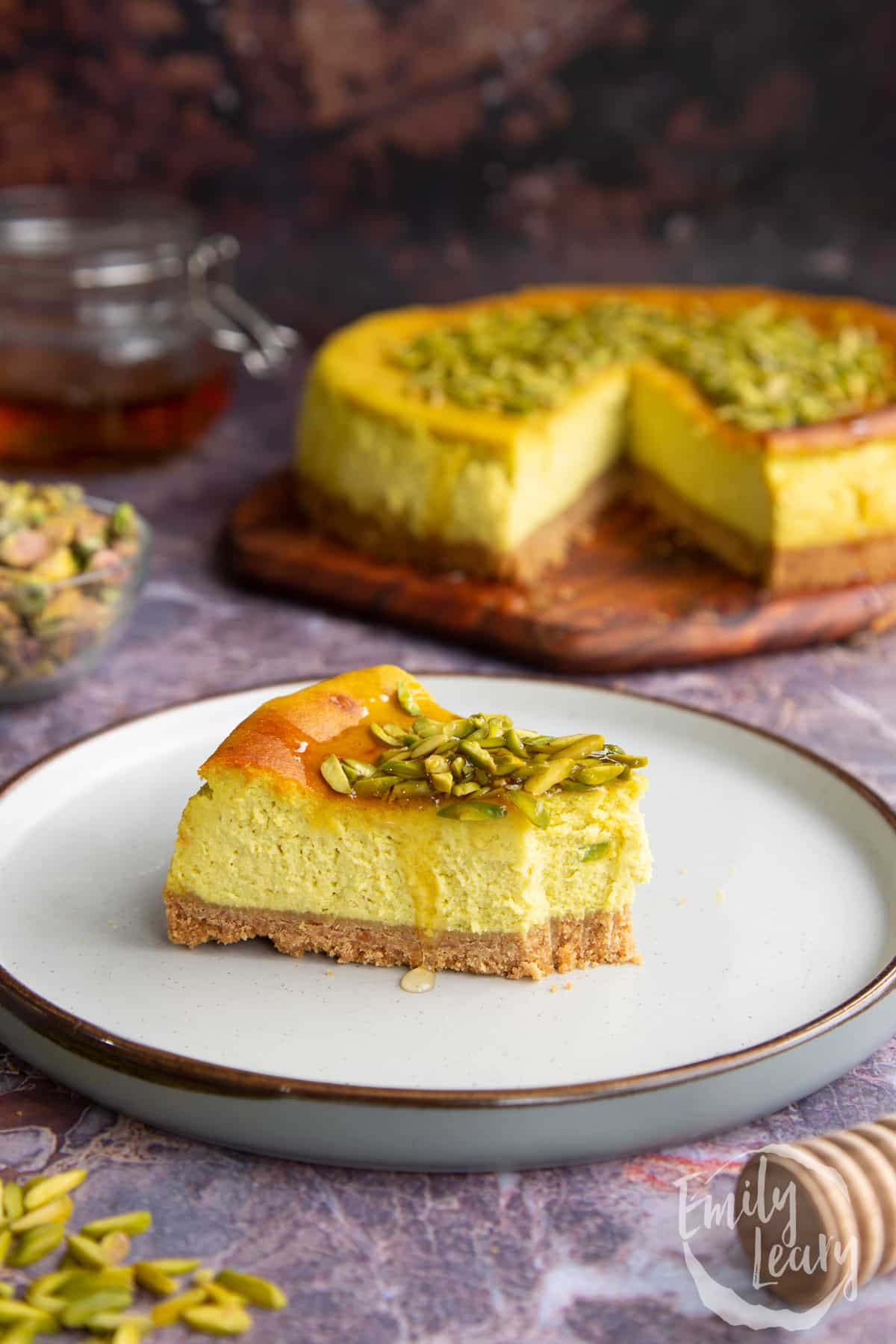
Pointers, tricks and troubleshooting tips for the perfect Pistachio cheesecake
Is Pistachio cheesecake easy to make?
This honey-drizzled Pistachio cheesecake is super easy to make! It takes just 20 minutes to prep and an hour to cook. Then all you have to do is wait for it to cool down before enjoying it.
Once your biscuits are crushed, you'll combine them with melted butter to form the base in the lined cake tin.
Then you'll gently mix the filling ingredients into a smooth filling mix. But make sure not to whip the cream! Once the other ingredients are combined, you'll pour the filling on top of the biscuit base - then bake to perfection.
Finally, you'll leave your cheesecake to cool and set, then transfer it to the fridge overnight so it develops a creamy, decadent texture. This step can have some issues, so I've added some extra tips below.
Above there is some step by step photos to accompany each stage of the recipe. So you can check the pictures to see if your cheesecake looks like it's on the right track.
Will I need any special equipment for my Pistachio cheesecake?
This recipe is mixed in one bowl and cooked in one tin, so you should have everything you need. The only equipment you might not have is a 9-inch springform cake tin. Luckily, they’re very common, so you should be able to pick one up from a supermarket or Amazon.
There is a full list of suggested equipment on the recipe card below.
There is a complete list of suggested equipment on the recipe card below.
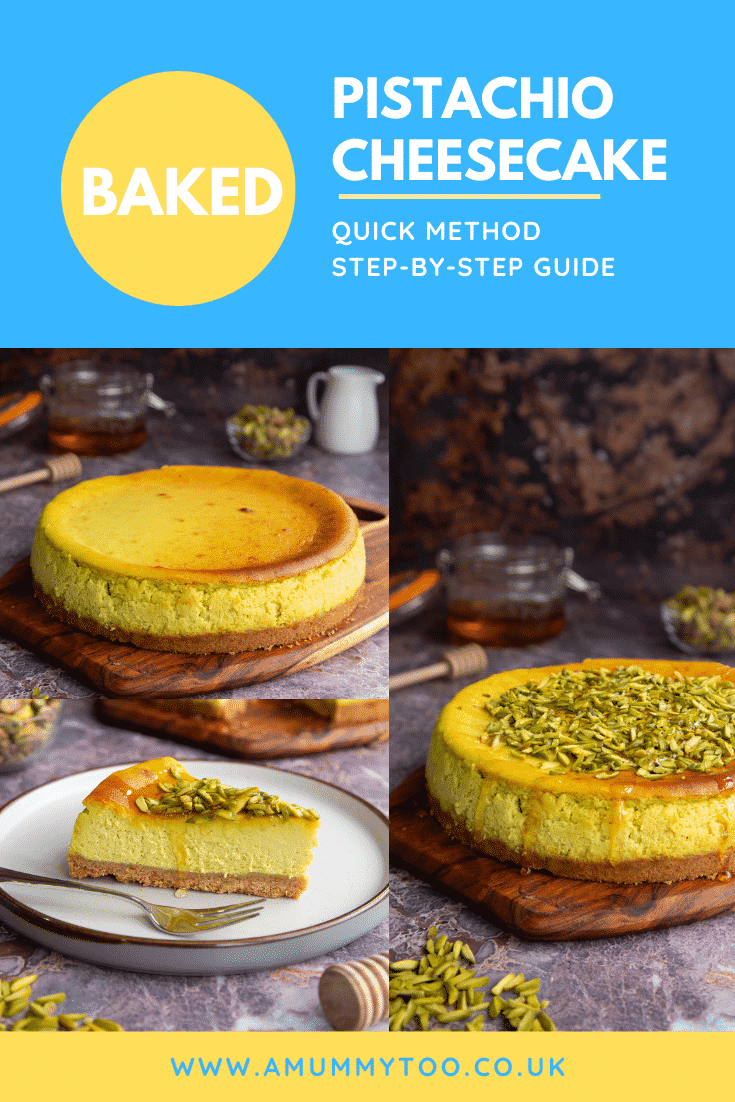
I haven't got pistachio paste. Can I use something else?
If you can’t find any pistachio paste in store, you can make your own or use a pistachio butter. However, keep in mind that shop bought pistachio butter/paste can have extra ingredients (see below).
Is pistachio paste the same as pistachio butter?
Yes, pistachio paste and pistachio butter are basically the same thing - blended pistachios. So if you can’t make or buy pistachio paste, you could use a pistachio butter.
However, bear in mind that pistachio butter can sometimes come with added oil, salt or sweetener. You can find 100% pistachio-based pistachio butter from Amazon or online grocery retailers.
There are several kinds of pistachio paste that are sold for use in Italian desserts like cannolis. These varieties of pistachio paste for cannolis aren’t suitable for this recipe, as they usually contain icing sugar.
So the best bet is to find a 100% pistachio butter or make it from scratch so you know exactly what went into it. I have an easy pistachio paste recipe that lets the natural oils and moisture in the pistachios work to create a lovely smooth paste.
How can I tell if eggs have gone off?
It's always best to use fresh ingredients when baking, especially eggs. This is because eggs lose water content as they get older and become more unpredictable.
You should never eat or cook with a spoiled egg. So if your egg has any discolouration, odd appearance, or a strange or foul odour, it is most likely rotten.
If your egg has spoiled, you should immediately throw it away and thoroughly wash any pots and utensils that have come into contact with it.
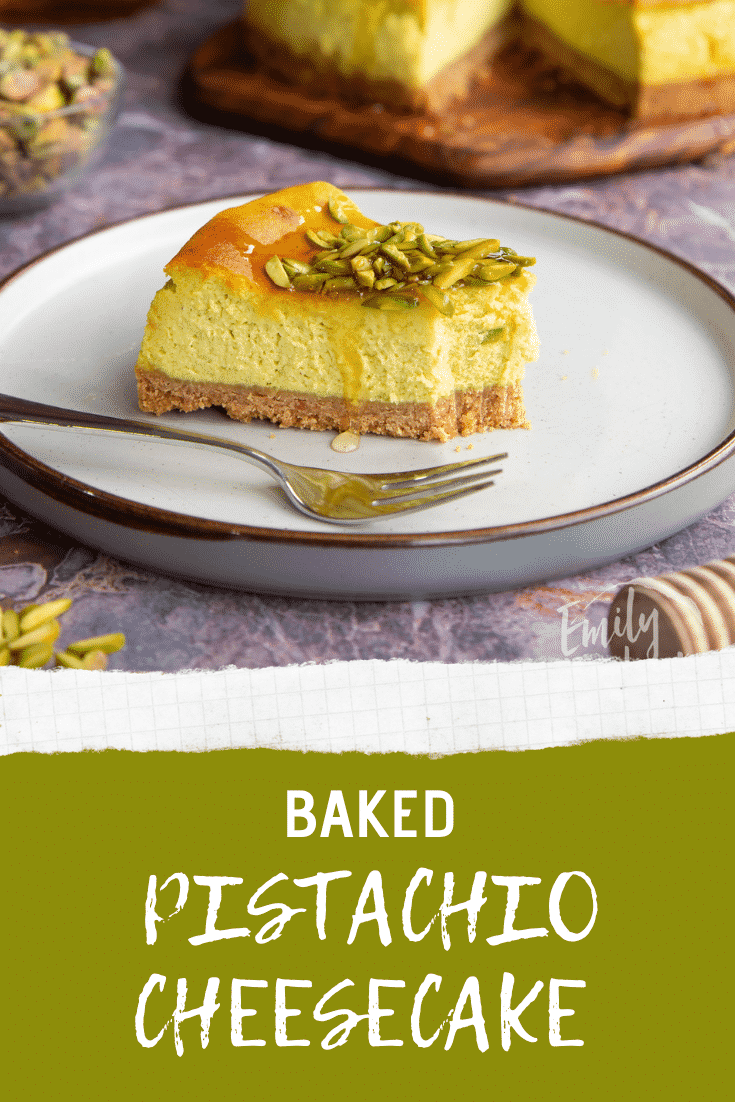
How can I check if my eggs are fresh?
If you aren't sure if your egg is fresh, you can drop it into a cup or bowl of cold water. If it floats, it is spoiled and if it sinks, it should be safe to eat. This is called a float test.
However, it's important to note that some spoiled eggs can still sink. So to ensure you don't contaminate a recipe with a rotten egg, crack your eggs into a separate bowl or cup before adding them to a recipe. This also lets you check the egg for any broken shell fragments.
Egg safety is crucial if you're cooking for someone in a vulnerable or at-risk group, such as older people, people living with health conditions, or a pregnant person.
A Mummy Too does not give medical advice. Please consult with your medical professional.
How can I tell if the butter has gone off?
When butter spoils, it turns dark yellow, sometimes with translucent patches. Spoiled butter can also develop a layer of condensation on it as water escapes.
These changes occur when bacteria cause the fat, protein and liquid molecules to separate. The lactic acid released during this process can also produce a sour smell and give the butter a fizzy quality.
Sometimes spoiled butter can look completely fine, so you should taste it before including it in a recipe. If it tastes/feels fizzy, it isn't safe to use.
You should also check that there are no crumbs in the butter as they can contain allergens and harbour bacteria.
In the UK, butter is sold with both a Best Before date and a Use By date. Butter should still be safe to use after the Best Before date, but it might not be at its best (hence the name).
Unlike Best Before dates that indicate quality, you should never use food beyond its Use By date.
This should give you a good indication of whether the butter is still ok to use. However, these dates are voided if you don't store your butter according to the packet instructions.
For example, many people keep their butter out of the fridge in a butter dish. Unfortunately, this isn't feasible in most modern homes, as central heating makes them too warm to keep butter at the advised safe temperature.
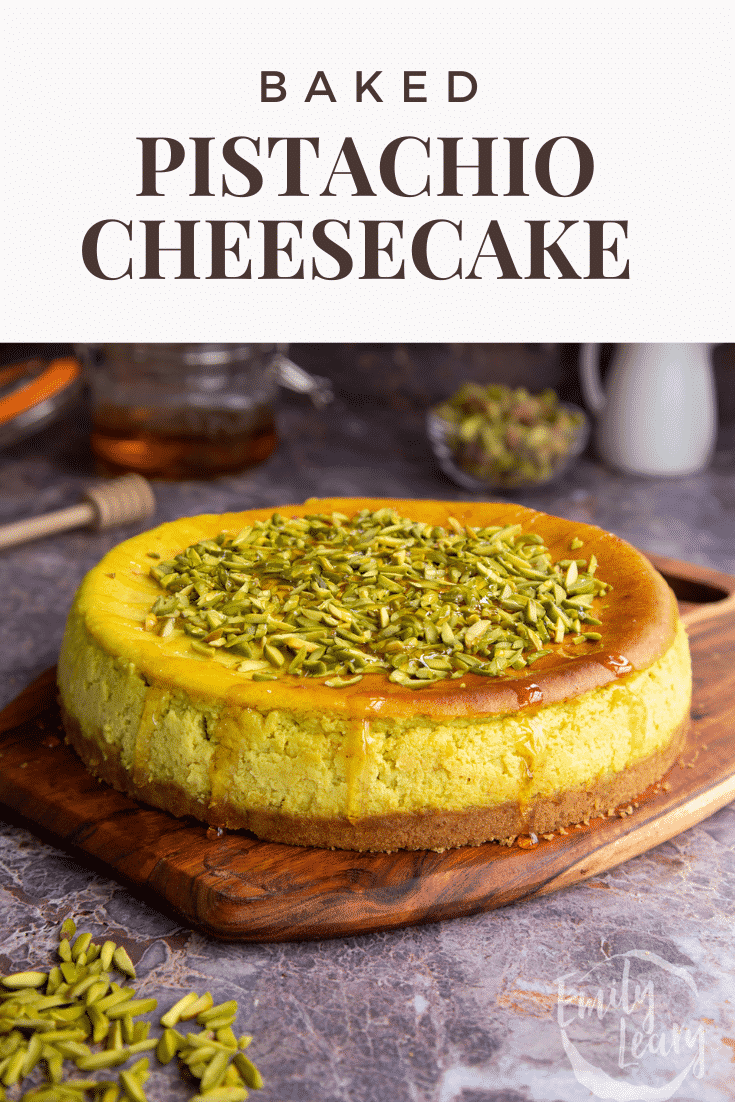
Is double and heavy cream the same thing?
Double cream is the British equivalent of heavy cream. They're more or less the same, but double cream is actually slightly thicker due to higher fat content.
However, they should both work similarly in recipes, so don’t worry too much if you can’t find double cream abroad.
How can I tell if the cream has gone off?
When double cream (heavy cream) spoils, it behaves similarly to butter and milk, though one key difference.
Double cream sometimes has a slight amount of separation or thicker cream. This is often the fat rising to the top of the container. If you store your cream correctly and it's within its use-by date, some separation is acceptable. However, if your cream is old, open and has excessive separation, you should discard it.
Sour cream will have a strong, sour smell like spoiled milk or butter. The separation will be much more than usual, and there may even be patches of clear liquid. This happens when bacteria break down the bonds between fat, protein and liquid.
Finally, if your cream has any mould growing on it, that's a clear sign it has gone off.
If your cream has spoiled, you should immediately discard it and wash anything it came into contact with to avoid cross-contamination.
How can I tell if cream cheese has gone off?
When cream cheese spoils, it tends to dry out and develop cracks across the surface. Also, like butter, the liquid and the fat separate as it spoils.
So it may have beads of sweat (gross!), or the liquid might even completely separate and pool at the bottom of the pack.
Spoiled cream cheese will often develop mould, as it's a perfect environment for bacteria to grow.
If your cream cheese has any of these signs, you should immediately discard it and wash anything it came into contact with.
Can I use single cream instead of double cream?
No, single cream has a much lower fat content than double (heavy) cream, so it won’t work for this recipe. It will most likely cause your cheesecake filling to curdle while cooking. So stick to double cream for this recipe.
Is this Pistachio cheesecake suitable for vegetarians?
Yes, this recipe is totally vegetarian as there is no gelatine in the filling!
Double-check all of your ingredients and labels to check that they are suitable for vegetarians. Also, don't forget to check anything extra you intend to serve the recipe with.
Is this Pistachio cheesecake suitable for vegans?
This Pistachio cheesecake recipe isn't vegan as it contains dairy, egg and honey.
Vegan cheesecake recipes use different ingredients to get the same texture as dairy, so just swapping the ingredients for vegan counterparts and cooking according to the instructions for this recipe might not work.
However, if you want to give it a try, you could try making the recipe with the substitutions below.
Double-check all of your ingredient labels to ensure that they are suitable for vegans. Also, don't forget to check anything extra you intend to serve the recipe with.
Potential vegan substitutions:
- Cream: You could use Alpro or Oatly plant-based double cream instead of dairy cream. I've noticed in vegan baking recipes using ½ a teaspoon of xanthan gum in plant-based double cream helps it thicken similarly to vegan cream, so you could try that.
- Butter: Many supermarkets sell dairy-free butter in refrigerated aisles with dairy butter. Flora and Naturli are fairly common brands in the UK and Western Europe. I find they work best as they have similar fat content to diary butter (80%). So if you use another brand, make sure it has similar fat content.
- Cream cheese: A few vegan baked cheesecake recipes use Tofutti cream cheese for the filling because it has a relatively high-fat content compared to other vegan cream cheeses (8g fat per 30g). Tofutti brand isn't widely available in the UK, but, this vegan cream cheese from Sainsbury's has a similar fat content of 8.4g per 30g.
- Eggs: Some vegan baked cheesecake recipes recommend using 4 teaspoons of cornflour instead of eggs. However, you can also find powdered vegan egg replacer in the baking aisle or on the Free From aisle of your local supermarket. I'm not sure which would work best, as I haven't tried a vegan version of this recipe. Let me know how it goes!
- Biscuit: Many digestive biscuits/ graham crackers are accidentally vegan. So check the labels, and you may be able to use your regular brand. If not, the Free From section of your supermarket will have a brand you can use.
- Honey: Maple syrup or Agave would work well as replacements for the sweetness of honey, but they won’t have the same taste.
Is Pistachio cheesecake gluten-free?
This recipe contains gluten, but it’s easy enough to adjust for someone who doesn’t eat gluten.
The only ingredients in this recipe that contain gluten are the biscuits for the base and the tablespoon of flour. So if you use gluten-free biscuits and swap the spoon of flour for gluten-free flour then this recipe will be fine for someone avoiding gluten!
Double-check all of your ingredient labels to ensure that they are gluten-free. Also, don't forget to check anything extra you intend to serve the recipe with.
Is Pistachio cheesecake keto-friendly?
This cheesecake contains sugar and carbohydrates from the biscuits and flour. However, you could adapt the cheesecake for a keto diet if you replace three ingredients.
- First, you’ll need to swap the digestive biscuit base for a keto-friendly base. There are many keto cheesecake recipes that use a nut base, using ground almonds and flours like chia flour. However, you may want to check a keto cheesecake recipe for cooking methods, as a nut base could burn.
- For the filling, you’ll need to use a sweetener like erythritol or xylitol instead of sugar. It’s best to check the packet instructions for the quantities to use instead of sugar.
- Finally, I added a tablespoon of flour to the filling. Feel free to use almond flour or skip this step, though the texture of the filling will be different.
Is Pistachio cheesecake healthy?
This cheesecake contains a fair amount of fat and sugar, so it isn’t suitable for an everyday snack. But there’s nothing wrong with indulging every now and then!
Is Pistachio cheesecake safe to eat while pregnant?
This recipe should be perfectly safe for a pregnant person. You may worry when you see soft cheese in an ingredients list, but this recipe uses a pasteurised cream cheese (like Philadelphia).
Doctors tell pregnant people to avoid soft cheeses as they can contain harmful bacteria. However, 99% of cream cheese sold in supermarkets is pasteurised and safe to eat. Though you should make sure to check labels just in case.
If you’re concerned about what to eat while pregnant or serve to a pregnant loved one, the NHS has some great advice on foods to avoid during pregnancy.
Ensure all of your ingredients are in good condition and that you prepare this cheesecake safely and hygienically.
A Mummy Too does not offer medical advice. Please seek help from a medical professional if you need further information or have any concerns.
Is Pistachio cheesecake suitable for babies and toddlers?
No, this recipe contains sugar, and the NHS advises that you shouldn't feed sugar to babies and toddlers. For more information, the NHS has some fantastic resources on their website on what to feed babies and young children.
A Mummy Too does not give medical advice. If you have any questions or concerns, please speak to a health professional.
Why do I have to chill my baked cheesecake overnight?
When your cheesecake comes out of the oven, it will still be quite soft. This is because the fat in the dairy has melted. Once it cools down the fat will set, causing the texture to become firmer and rich.
Chilling your cheesecake overnight gives the cheesecake time to set completely, and for the moisture to
How should I cool my cheesecake?
Once you’re sure it’s cooked, the best way to cool a baked cheesecake is to leave it in the oven with the door ajar for at least an hour. This will help the cheesecake gradually cool down. Gradually cooling the cheesecake will help avoid your cheesecake cracking, as detailed below.
Once your cheesecake is cool or only very slightly warm, you can transfer it to the refrigerator and cover it over with a
Can I put a warm cheesecake in the fridge?
No, you should wait for your cheesecake to cool down until it is room temperature before refrigerating it. If you put a warm cheesecake in the fridge, the sudden drop in temperature will cause the cheesecake to crack.
But more importantly, it’s unsafe to put warm food in a fridge as it increases the temperature of perishable food.
How should I store my Pistachio cheesecake?
The best and safest place to store your cheesecake is in the fridge. The cheesecake filling contains dairy which will spoil if left at room temperature for extended periods.
I usually store cheesecakes in a cake container, or I use an upside-down biscuit tin as a lid to cover the cheesecake.
How long does my Pistachio cheesecake keep?
Your Pistachio cheesecake should keep for up to 4 days, as long as you store it in a sealed container in the refrigerator.
Can I leave my Pistachio cheesecake out on the counter?
No, if you leave your Pistachio cheesecake out on the counter it will most likely collapse and then spoil within a few hours.
Can I make my Pistachio cheesecake ahead?
Yes - this Pistachio cheesecake needs to be made around 12 hours ahead to give it time to set properly. So it’s a perfect dessert to make ahead of time.
Can I keep my Pistachio cheesecake in the refrigerator?
Yes! The best place to keep your cheesecake is in the refrigerator. You’ll need to refrigerate it to help it set, then once you’re finished serving it, keep it covered in the fridge. It should be safe to eat for up to 4 days.

Can I freeze my Pistachio cheesecake?
You can freeze your cheesecake and baked cheesecakes freeze better than no-bake cheesecakes. Dairy tends to split when it defrosts, as the water molecules defrost into liquid before the fat and protein defrost, meaning they are no longer bound together.
So a baked cheesecake, which has lost water content during cooking, is less likely to split as there is less water. However, eating a defrosted cheesecake won’t be as nice as having a freshly made cheesecake, as the base will be soggy.
The best way to freeze cheesecake is to wrap it in cling film once it has set. Then freeze the wrapped whole cheesecake or wrapped slices inside an airtight container. Cling film will protect the cheesecake from damage and freezer burn.
When you want to defrost your cheesecake, you should remove the cling film while it is still frozen. Otherwise, the cling film might pull apart the defrosted cheesecake when you remove it.
How can I defrost a frozen baked cheesecake?
To defrost your frozen Pistachio cheesecake, place it into a sealed container and remove the cling film while it’s still frozen. Then seal up the container and place it into the fridge and leave it overnight or for at least 8 hours.
Once the cheesecake is fully defrosted you should eat it within 2 days.
Can I make my Pistachio cheesecake in a different quantity?
If you want to make a different sized cheesecake go ahead. You can use an online recipe calculator to work out a different yield size.
However, the timing for this recipe wouldn’t work for a different sized cheesecake. So you’ll need to bake the cheesecake for longer if you make a bigger one, or less time if you make a small or individual portion.
It’s probably best to look at the timings and temperatures for a cheesecake recipe of similar size you plan to make and use that.
Can I make Baked chocolate cheesecake in a different tin/tray?
For this recipe, I used a springform 9-inch cake tin. If you don't have one, feel free to use a square (or other shaped) tin of a similar size.
Just make sure that your alternative tin will give your cheesecake a similar depth and surface area. Otherwise, it will affect the way the cheesecake cooks.
For example, a very wide tin will make a shallow cheesecake that cooks very quickly and burns more easily.
Can I make Pistachio cheesecake in a stand mixer like a KitchenAid or Kenwood Mixer?
You could use a stand mixer to combine your filling ingredients. However, use the lowest setting as you don't want to whisk your cream or cream cheese. You only need to combine the ingredients into a smooth mixture.
Can I make Pistachio cheesecake with a food processor?
Yes, you could use a food processor to blitz your biscuits for the cheesecake base. I wouldn’t use a food processor for any other mixing, or it would overmix the filling.
What makes a cheesecake dense or fluffy?
Adding flour or cornstarch to a cheesecake will make it denser, as the starch molecules swell up when heating. If you make a cheesecake without flour or cornstarch it will be more creamy and loose, or even fluffy.
However, a cheesecake without starch is more susceptible to curdling. It’s thought that this is because starch slows down the curdling process, giving the cheesecake enough time to cook before it curdles.
What does egg yolk do in cheesecake?
Egg is a good way to thicken cheesecake filling, but it also acts as a natural emulsifier. An emulsifier is an ingredient that helps bind liquid and fat together. So the egg yolk in this cheesecake helps the liquid from the dairy hold together in a smooth mixture with the fat and protein from the dairy and other ingredients.
If you think about it, a cheesecake filling is just a custard but instead of milk, it uses cream and cream cheese. So an egg yolk does the same job in a cheesecake as it does in custard.
How do I make my cheesecake firmer?
This cheesecake should be set quite firmly, as it has plenty of egg and fat in it. If it was any firmer I would find it a bit unpleasant, to be honest!
What does heavy cream do in cheesecake?
Heavy or double cream (and sour cream), add moisture to a cheesecake while helping the fat to liquid ratio stay within the range for a filling.
If you added milk or single cream to a cheesecake filling instead of cream you would end up with a wet soup. Excess liquid would stop the egg and dairy proteins from uncurling and linking.
Equally, if there wasn’t the extra fat from the cream, the cheesecake wouldn’t have enough fat to set properly when it cools down.
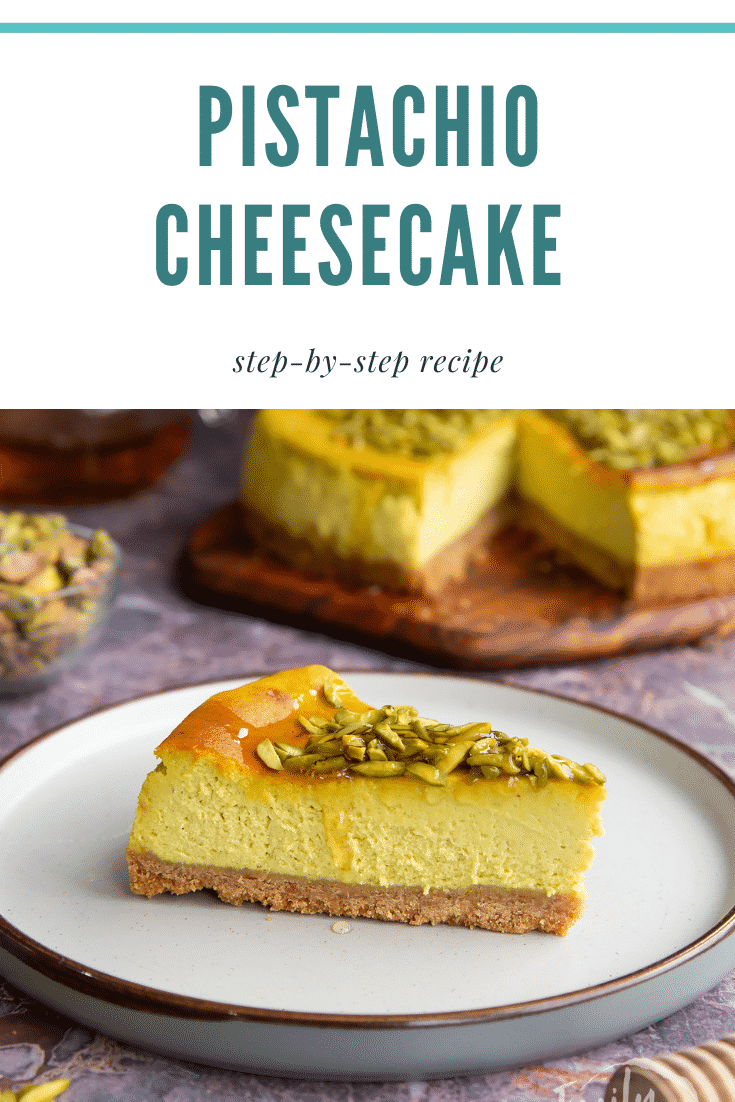
How can I make sure my Pistachio cheesecake is perfectly cooked?
- Ratios: As I said, too much liquid or too little fat will change the way your cheesecake cooks. So make sure that you measure out your ingredients before you begin cooking and place them in bowls in front of your cooking station. This will ensure you don't forget to add anything.
- Oven temperature: If you think your oven runs hotter than the dial states, you should get an oven thermometer before cooking your cheesecake. Temperature is key to getting the cheesecake right. If the oven is too hot it can cause the cheesecake filling to curdle before it cooks, crack excessively or burn on top.
- Full fat: Use full-fat cream cheese for the best results. Full fat cream cheese will give you a creamy and dense cheesecake filling. Light or low-fat versions tend to have a higher water content, which may affect the cooking time and result in a wetter, or even loose cheesecake.
- Pistachio: For best results, I find using homemade pistachio paste gives a more vibrant green in this cheesecake. I would also recommend buying raw pistachio slivers, rather than slicing roasted pistachios.
- Is it cooked? Make sure your cheesecake isn’t too wet once the cooking time is over. It should be set on top and darker or slightly golden on top, though it should still wobble a little. The cheesecake edges should be golden and come away from the edge of the tin. If it isn't cooked, give it an extra 5-10 minutes and check it again. Don't worry if it wobbles slightly, it will firm up as it cools down.
- Be cool: To reduce the chance of cracking, it’s best to leave your cheesecake to cool in the oven once you’re certain it’s cooked. Leaving it in the oven helps it cool slowly, which stops the cheesecake from contracting and pulling away from the tin quickly. You can leave cheesecake in the oven for an hour or more with the oven door ajar slightly. Then let it cool completely at room temperature and transfer to the fridge.
How can I add/change the flavours in my Pistachio cheesecake?
The most obvious addition to this Pistachio cheesecake would be rosewater or candied rose petals. Rose and pistachio is a match made in heaven and would give this cheesecake more of a Levantine twist.
I also find white chocolate and pistachio go together beautifully. So you could drizzle some melted white chocolate over the top of your (cooled) cheesecake.
Where do pistachios come from?
The pistachio tree is thought to have originated in what is now known as Iraq and Afghanistan, though it was first cultivated (or grown deliberately) closer to Central Asia.
Pistachio trees can live for as long as 300 years, and many older trees are still producing pistachios sold today. So you could be eating pistachios from the same tree as your great, great, great…grandparents!
Print this pistachio cheesecake recipe
Pistachio Cheesecake Recipe
Ingredients
For the base
- 260 g (9.2 oz) digestive biscuits (graham crackers)
- 1 tbsp golden caster sugar (superfine sugar)
- 85 g (3 oz) salted butter
For the filling
- 350 g (12.3 oz) light cream cheese room temp
- 250 g (8.8 oz) full fat cream cheese room temp
- 175 ml (5.9 floz) double cream room temp
- 2 medium free range eggs room temp
- medium free range egg yolk room temp
- 1 tbsp plain white flour (all purpose flour)
- 1 tsp vanilla extract
- 200 g (7.1 oz) golden caster sugar (superfine sugar)
- 200 g (7.1 oz) pistachio paste
To top
- 30 g (1.1 oz) pistachio slivers or chopped pistachios
- 2 tbsp honey
Instructions
Make the base
- Crush or blend the biscuits to resemble coarse sand.
- Add the sugar and melted butter and mix well.
- Press into the base of a large springform cake tin, flattening with a spoon or base of a tumbler.
- Cook at 170C/340F (150C/300F fan) for no more than 5 mins, then set aside to cool.
Make the filling
- Put the cream cheese, double cream, eggs, flour, vanilla, sugar and pistachio paste in a large bowl. Briefly whisk together until just combined. Don't overwhisk as you'll introduce too much air.
- At this stage, if you like, you can add a small drop of green food colouring to make the filling more vibrant.
- Pour the batter into the tin on top of the biscuit base.
- Bake at 170C/340F (150C/300F fan) for 1 hour until firm but wobbly (not ripply) if shaken.
- Run a sharp knife carefully around the inside of the tin to ensure the cheesecake doesn't stick, which can cause cracks as it cools.
- Cool in the tin on a rack and when cold, cover and store in the fridge to set overnight.
To finish
- One the cheesecake has chilled, run a knife around the inside of the tin again and unlock to release the sides. It should then lift onto a board cleanly.
- Sprinkle the pistachio slivers (or chopped pistachios) on top of the cheesecake and drizzle with honey.
- Your cheesecake is now ready to slice with a sharp knife and serve.
Video
Notes
Nutrition
Pin pistachio cheesecake this recipe
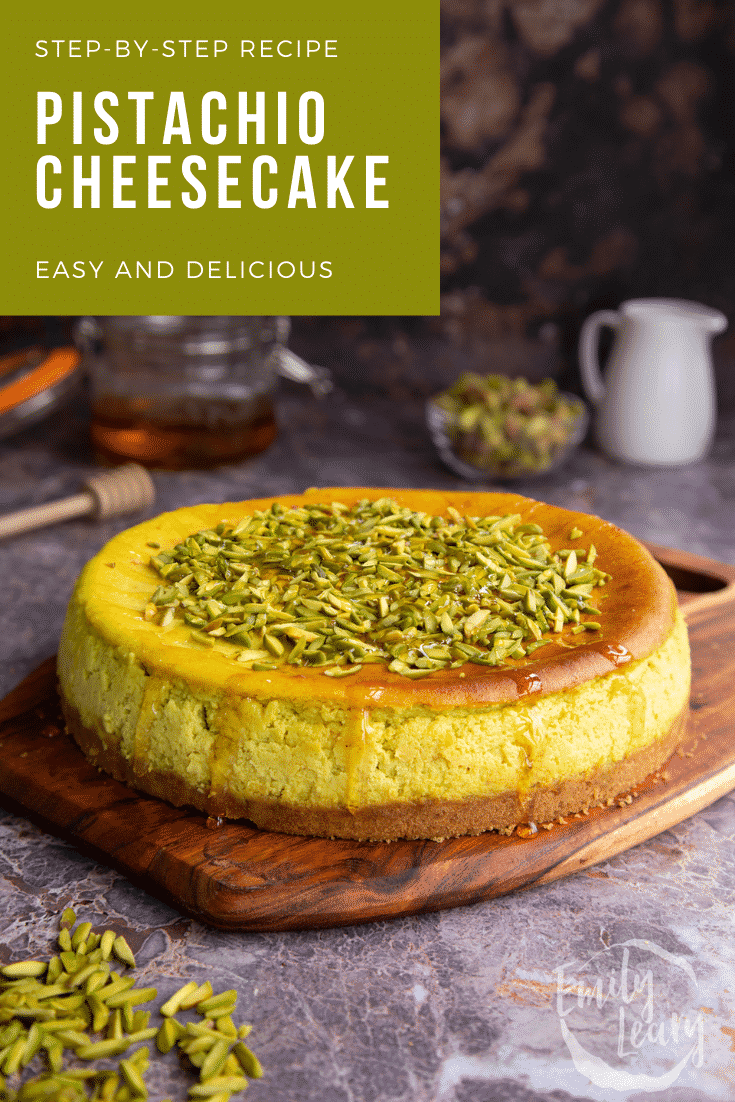
More cheesecake recipes to try
Have you got my book?

'This is a great kids cookery book. Emily is a star' - Simon Rimmer
'The book I'd like to force into any mother's kitchen' - Prue Leith
"A fab book with a plan." - Jane Devonshire, 2016 Masterchef UK winner
'Emily has managed to combine her mummy knowledge and passion for food to make a truly helpful and brilliant cookbook' - Priya Tew, RD, BSc (Hons), Msc
Get Your Kids to Eat Anything is an achievable 'how to' for parents in the battle to overcome picky eating and 'make new the norm'. Emily Leary's unique 5-phase programme looks at the issue of 'fussy eating' in a holistic way that links imagination with food, and which situates parents alongside - not in opposition to - their children.



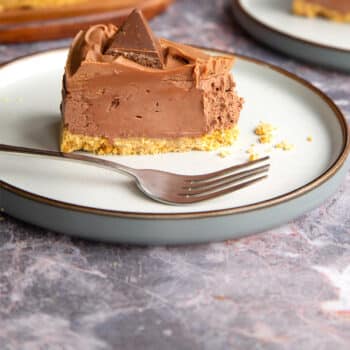
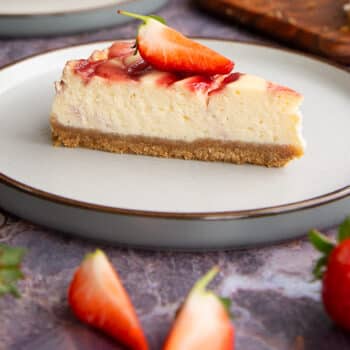
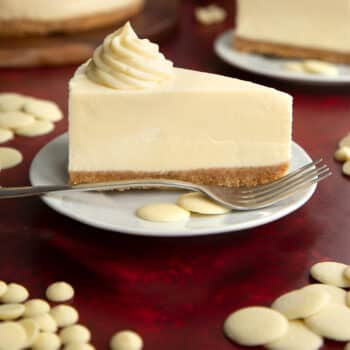
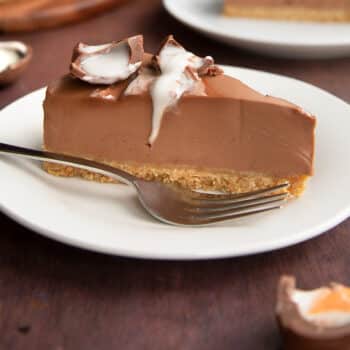
Leave a Reply